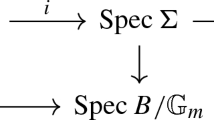Abstract
The principal goal of this paper is to develop Kolyvagin’s descent to apply with the big Heegner point Euler system constructed by Howard for the big Galois representation \(\mathbb T \) attached to a Hida family \(\mathbb F \) of elliptic modular forms. In order to achieve this, we interpolate and control the Tamagawa factors attached to each member of the family \(\mathbb F \) at bad primes, which should be of independent interest. Using this, we then work out the Kolyvagin descent on the big Heegner point Euler system so as to obtain a big Kolyvagin system that interpolates the collection of Kolyvagin systems obtained by Fouquet for each member of the family individually. This construction has standard applications to Iwasawa theory, which we record at the end.
Similar content being viewed by others
Notes
In the sense of Nekovář [21, §12.7.10]. The twisted eigenform we have in mind is denoted by \(g_\mathcal{P }\) in loc.cit.
Attentive reader will notice that Mazur and Rubin never treat Heegner points. It was Howard [16] who was the first to study the Heegner points from the perspective offered by the work of Mazur and Rubin.
In the sense we have explained at the start of Sect. 3.1.
The attentive reader will notice that the extra factor \(\alpha \) is not explicit in the statement of Fouquet [9, Theorem B(iii)], however that Fouquet’s element \(z_\infty \) differ from the \(\mathfrak z _{\infty }\) defined below by a factor of \(\alpha \).
Note that the extra factor \(\alpha \) in Fouquet’s[9] arguments is needed to obtain Kolyvagin systems for each specialization of \(\mathbb T \). Once one obtains those (in our case, they descend from our big Heegner point Kolyvagin system), the arguments of Sect. 6 in loc.cit. carry out verbatim.
References
Arnold, T.: On the main conjecture for a self-dual Hida family (2011, preprint)
Büyükboduk, K.: \(\Lambda \)-adic Kolyvagin systems. IMRN 2011(14), 3141–3206 (2011)
Büyükboduk, K.: Deformations of Kolyvagin systems, 2012 (Submitted, available upon request)
Cartan, H., Eilenberg, S.: Homological Algebra. Princeton University Press, Princeton (1956)
Deligne, P.: Formes modulaires et répresentations \(\ell \)-adique. In: Séminaire Bourbaki (1968/69), Exp. No. 55. Lecture Notes in Math., vol. 179, pp. 139–172. Springer, Berlin (1971)
Emerton, M., Pollack, R., Weston, T.: Variation of Iwasawa invariants in Hida families. Invent. Math. 163(3), 523–580 (2006)
Fouquet, O., Ochiai, T.: Control theorems for Selmer groups of nearly ordinary deformations. J. Reine Angew. Math. 666, 163–187 (2012)
Fouquet, O.: Systémes D’Euler pour les Tours de Courbes de Shimura. Thesis (Ph.D.)-Institut de Mathématiques de Jussieu, Université Pierre et Marie Curie (Paris VI) (2008)
Fouquet, O.: Euler systems in the Iwasawa theory of ordinary modular forms. In: Algebraic Number Theory and Related Topics 2008, RIMS Kôkyûroku Bessatsu, B19, pp. 255–276. Res. Inst. Math. Sci. (RIMS), Kyoto (2010)
Fontaine, J.-M., Perrin-Riou, B.: Autour des conjectures de Bloch et Kato: cohomologie galoisienne et valeurs de fonctions \(L\). In: Motives (Seattle, WA, 1991), Volume 55 of Proc. Sympos. Pure Math., pp. 599–706. Amer. Math. Soc., Providence, RI (1994)
Greenberg, R.: Trivial zeros of \(p\)-adic \(L\)-functions. In: \(p\)-Adic Monodromy and The Birch and Swinnerton-Dyer Conjecture (Boston, MA, 1991), Volume 165 of Contemp. Math., pp. 149–174. Amer. Math. Soc., Providence, RI (1994)
Hida, H.: Galois representations into \({\rm GL}_2({\bf Z}_p[[X]])\) attached to ordinary cusp forms. Invent. Math. 85(3), 545–613 (1986)
Hida, H.: Iwasawa modules attached to congruences of cusp forms. Ann. Sci. École Norm. Sup. (4) 19(2), 231–273 (1986)
Hida, H.: On \(p\)-adic Hecke algebras for \({\rm GL}_2\) over totally real fields. Ann. Math. (2) 128(2), 295–384 (1988)
Hida, H.: On nearly ordinary Hecke algebras for \({\rm GL}(2)\) over totally real fields. In: Algebraic Number Theory, Volume 17 of Adv. Stud. Pure Math., pp. 139–169. Academic Press, Boston, MA (1989)
Howard, B.: The Heegner point Kolyvagin system. Compos. Math. 140(6), 1439–1472 (2004)
Howard, B.: Variation of Heegner points in Hida families. Invent. Math. 167(1), 91–128 (2007)
Mazur, B., Rubin, K.: Kolyvagin systems. Mem. Am. Math. Soc. 168(799), viii+96 (2004)
Mazur, B., Tilouine, J.: Représentations galoisiennes, différentielles de Kähler et “conjectures principales”. Inst. Hautes Études Sci. Publ. Math. (71), 65–103 (1990)
Nekovář, J.: Kolyvagin’s method for Chow groups of Kuga-Sato varieties. Invent. Math. 107(1), 99–125 (1992)
Nekovář, J.: Selmer complexes. Astérisque (310), viii+559 (2006)
Ochiai, T.: Euler system for Galois deformations. Ann. Inst. Fourier (Grenoble) 55(1), 113–146 (2005)
Ochiai, T.: On the two-variable Iwasawa main conjecture. Compos. Math. 142(5), 1157–1200 (2006)
Pottharst, J.: Analytic families of finite-slope Selmer groups (2011, preprint)
Rubin, K.: Euler Systems, Volume 147 of Annals of Mathematics Studies. Hermann Weyl Lectures. The Institute for Advanced Study. Princeton University Press, Princeton (2000)
Skinner, C.M., Wiles, A.J.: Residually reducible representations and modular forms. Inst. Hautes Études Sci. Publ. Math. (89):5–126 (2000), 1999
Skinner, C.M., Wiles, A.J.: Nearly ordinary deformations of irreducible residual representations. Ann. Fac. Sci. Toulouse Math. (6) 10(1), 185–215 (2001)
Acknowledgments
The author wishes to thank Olivier Fouquet, Barry Mazur and Jan Nekovář, discussions with whom led the author to this work. He also thanks the anonymous referee for his comments and suggestions. The author acknowledges a Marie Curie Grant EU-FP7 230668 as well as partial support from TÜBİTAK and FONDECYT in the duration of this project.
Author information
Authors and Affiliations
Corresponding author
Rights and permissions
About this article
Cite this article
Büyükboduk, K. Big Heegner point Kolyvagin system for a family of modular forms. Sel. Math. New Ser. 20, 787–815 (2014). https://doi.org/10.1007/s00029-013-0136-4
Published:
Issue Date:
DOI: https://doi.org/10.1007/s00029-013-0136-4



